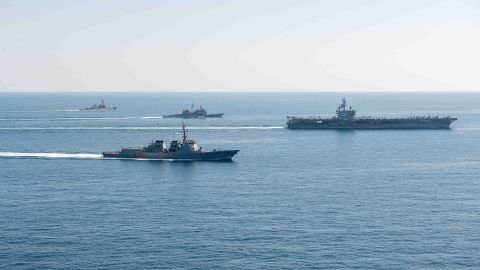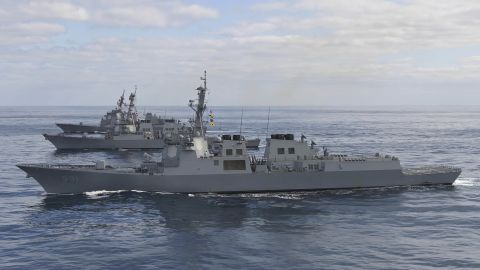[ad_1]
Seoul, South Korea
CNN
—
A year after Russia invaded Ukraine, Xi Jinping’s backing of Vladimir Putin has opened the door for the United States and partners in the Pacific to shore up sometimes frayed relationships to the detriment of Beijing.
In the past few months alone, Japan has pledged to double defense spending and acquire long-range weapons from the US; South Korea has acknowledged that stability in the Taiwan Strait is essential to its security; the Philippines has announced new US base access rights and is talking about joint patrols of the South China Sea with Australia, Japan and the United States.
Those might be the biggest initiatives, but they are far from the only events that have left China increasingly isolated in its own backyard as it refuses to condemn the invasion of a sovereign country by its partner in Moscow while keeping military pressure on the self-ruled island of Taiwan.
Analysts say all these things would have likely happened without the war in Ukraine, but the war, and China’s backing of Russia, has helped grease the skids to get these projects done.
Take the situation of Japan, a country limited in its post-World War II constitution to “self-defense” forces. Now it’s going to buy long-range Tomahawk cruise missiles from the US, weapons that could strike well inside China.
“I myself have a strong sense of urgency that Ukraine today may be East Asia tomorrow,” Japanese Prime Minister Fumio Kishida told a major defense conference in Singapore last summer.
In December, Kishida followed that up with a plan to double Tokyo’s defense spending while acquiring weapons with ranges well outside Japanese territory.
“The Japanese people have certainly taken notice of the situation in Ukraine, and it has made them feel more vulnerable as a nation,” said John Bradford, senior fellow at the S. Rajaratman School of International Studies in Singapore.
The nation that Japan feels particularly vulnerable to is China.
The People’s Liberation Army has been growing and modernizing its forces for years. On Sunday, Beijing announced its military budget for 2023, which will increase 7.2%. It marked the first time in the past decade that the military’s budget growth rate has increased for three consecutive years.
“The armed forces should intensify military training and preparedness across the board, develop new military strategic guidance, devote greater energy to training under combat conditions and make well-coordinated efforts to strengthen military work in all directions and domains,” outgoing Premier Li Keqiang said in a government work report.
China’s ruling Communist Party has for years been pressuring Taiwan. It sees the island as part of its territory, despite never having controlled it, and Chinese leader Xi has repeatedly refused to rule out the use of force in “reunifying” it with the Chinese mainland.
There’s worry that China may one day treat Taiwan as Russia has treated Ukraine.
Leaders in Tokyo have said peace across the Taiwan Strait is essential to Japan’s security. That’s really nothing new, but the urgency in Japan is.
“Japan has been strengthening its defense posture for years. The Ukraine situation made the key element of Kishida’s new National Security Strategy, the expected next steps in this strengthening, politically easier,” Bradford said.

In the current climate, the leadership in South Korea is watching Taiwan through a similar lens.
“Peace and stability in the Taiwan Strait is essential for peace and stability on the Korean Peninsula, and it’s indispensable for security and prosperity of the region as a whole,” Foreign Minister Park Jin told CNN recently.
There’s worry in Seoul that if US forces are drawn into any conflict with China over Taiwan, South Korea will look vulnerable in the eyes of Kim Jong Un in nuclear-armed North Korea.
That’s led to calls for South Korea to be more reliant on its own self-defense, including some calling for it to acquire its own nuclear weapons.
Meanwhile, Seoul and Tokyo are working more closely together on defense matters, including joint naval exercises with the US.
South Korea is also seeing increasing demands for the weapons it produces, like tanks, howitzers and fighter jets.

It signed a mulitibillion-dollar deal with Poland, Ukraine’s neighbor to the West and part of the US-led NATO alliance, for all of those items. And it is selling them in the region as well.
In the past month, Korea Aerospace Industries has announced it will sell 18 of its FA-50 light fighter jets to Malaysia.
Another operator of those FA-50s is the Philippines. Manila is also a customer for Korean-made warships and offshore patrol vessels.
And the web of cooperation gets even more intricate.
The Philippines is in talks with the US, Australia and Japan for joint patrols in the South China Sea, where China occupies islands that the Philippines also claims.
And Manila last month agreed to give Washington increased access to military facilities in the archipelago.
China may have been its own biggest detractor when it comes to the Philippines, regardless of what it was doing about the Ukraine war, analysts said.
Former President Rodrigo Duterte was not a fan of Washington and looked for ways to work with Bejing. But China never really showed any appreciation for that and his successor, Ferdinand Marcos Jr., has shown himself eager to work with the US and its allies, the analysts said.
“It is difficult for the new Marcos administration to justify accommodating Beijing’s policy preferences when previous attempts at doing so by the previous government were not reciprocated,” said Jeffrey Ordaniel, director of maritime security at the Pacific Forum and an assistant professor at Tokyo International University.
“Beijing’s continued bullying, like we saw in the case of the China Coast Guard blinding Philippines Coast Guard sailors with a laser (recently), has only helped to make the case for a stronger alliance” with Washington, said Blake Herzinger, a nonresident fellow and Indo-Pacific defense policy expert at the American Enterprise Institute.

China’s pressure on the Philippines has repercussions on the opposite side of the South China Sea, analysts said.
“Singapore and Vietnam have become even more open to greater US footprints in the region. They don’t want China to dominate Southeast Asia,” Ordaniel said.
But the Ukraine war has not been helpful in one key American partnership in the Indo-Pacific, the informal Quad alliance linking the US, Japan, Australia and India, according to analysts.
India, unlike the other three members, has not condemned Putin’s invasion of Ukraine.
“When the US, Australia, and Japan tried to condemn Russia through a joint statement, India refused…. India claimed that the Quad only tackles Indo-Pacific challenges, and since Russia isn’t in the region, this topic cannot be broached,” said Derek Grossman, senior defense analyst at the RAND Corporation.
But he said that split in the Quad doesn’t really distract from its focus.
“The Quad is all about how to deal with China,” Grossman said.
[ad_2]
Source link

